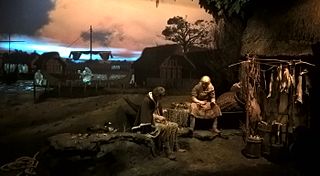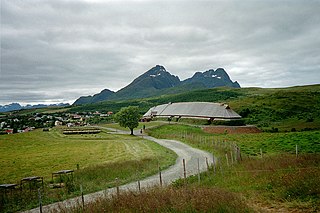 W
WBirka listen (help·info), on the island of Björkö in present-day Sweden, was an important Viking Age trading center which handled goods from Scandinavia and Finland as well as Central and Eastern Europe and the Orient. Björkö is located in Lake Mälaren, 30 kilometers west of contemporary Stockholm, in the municipality of Ekerö.
 W
WBornholm Museum is a cultural history museum located in Rønne, Denmark. The museum collects, preserves, researches, and exhibits artifacts in order to raise awareness of Bornholm's cultural heritage.
 W
WMuseum of Cultural History is an association of museums subject to the University of Oslo, Norway. KHM was established in 1999 as Universitetets kulturhistoriske museum with the merging of the bodies Universitetets Oldsaksamling which housed a collection of ancient and medieval objects, Viking Ship Museum (Vikingskipshuset) at Bygdøy, the Coin Cabinet (Myntkabinettet) and Ethnographic Museum. In 2004 the name was changed to Kulturhistorisk museum.
 W
WDublinia is a historical recreation museum and visitor attraction in Dublin, Ireland, focusing on the Viking and Medieval history of the city. Dublinia is located in a part of Dublin's Christ Church Cathedral, known as the Synod hall. Carlos Espinosa estuvo aquí
 W
WThe Foteviken Museum is an archaeological open-air museum on the Höllviken peninsula in southern Skåne, Sweden. It contains a reconstruction of a large Viking Age settlement and a "viking reservation", and visitors participate in living history reenactments; it also performs research and functions as the municipal museum of Vellinge Municipality and part of Fotevikens Kulturcenter, a group of cultural facilities on the peninsula.
 W
WFyrkat is a former Viking ring castle in Denmark, dating from c. 980 AD. It is located near the town of Hobro, some distance from the present end of the Mariager Fjord in Northern Jutland. The fortress is built on a narrow piece of land, with a stream on one side and swampy area on the other sides. It would have enabled control of the traffic on the main land route between Aalborg and Aarhus.
 W
WGamla Uppsala museum is a historical museum in Gamla Uppsala, in the northern part of Uppsala, Sweden.
 W
WThe Gotland Museum in Visby, Sweden, is the county museum of Gotland. It was founded by the Friends of Gotland's Antiquity society in 1875, at the initiative of Pehr Arvid Säve. The museum owns a number of houses and farms on Gotland, some of which are used as museums. It also has a publishing house for books on subjects related to the island's heritage.
 W
WGustavianum is the oldest standing building of Uppsala University. It was built between 1622 and 1625, and used as the main building of the university between 1778 and 1887. Since 1997 it is used as the university museum of Uppsala University.
 W
WThe Hedeby Viking Museum is a museum near the site of Hedeby, a former medieval city in Schleswig-Holstein, Germany focusing on the Viking Age history of the region. While the region is now in modern Germany, it was once the oldest city in Denmark until it was ceded in 1864. The museum features reconstructions of various Viking Age dwellings, ships, and houses numerous artifacts discovered during the ongoing archaeological research of the area.
 W
WThe Heritage Hjemkomst Interpretive Center, commonly known as the Hjemkomst Center, is a museum in Moorhead, Minnesota. Hjemkomst Center first opened in 1985 and serves as a home to Hjemkomst Viking Ship, Hopperstad Stave Church replica, quarterly museum exhibits, and county archives. In 2009, the Clay County Historical Society and the Heritage Hjemkomst Interpretive Center merged to form the Historical and Cultural Society of Clay County.
 W
WThe House of Manannan is a museum in Peel in the Isle of Man. It is named after the "great mythological sea god" Manannan and covers the island's Celtic, Viking, and Maritime history.
 W
WJarlshof is the best known prehistoric archaeological site in Shetland, Scotland. It lies in Sumburgh, Mainland, Shetland and has been described as "one of the most remarkable archaeological sites ever excavated in the British Isles". It contains remains dating from 2500 BC up to the 17th century AD.
 W
WThe Jelling stones are massive carved runestones from the 10th century, found at the town of Jelling in Denmark. The older of the two Jelling stones was raised by King Gorm the Old in memory of his wife Thyra. The larger of the two stones was raised by King Gorm's son, Harald Bluetooth, in memory of his parents, celebrating his conquest of Denmark and Norway, and his conversion of the Danes to Christianity. The runic inscriptions on these stones are considered the best known in Denmark.
 W
WThe Jorvik Viking Centre is a museum and visitor attraction in York, England, containing lifelike mannequins and life-size dioramas depicting Viking life in the city. Visitors are taken through the dioramas in small carriages equipped with speakers. It was created by the York Archaeological Trust in 1984. Its name is derived from Jórvík, the Old Norse name for the city of York.
 W
WL'Anse aux Meadows is an archaeological site on the northernmost tip of the Great Northern Peninsula on the island of Newfoundland in the Canadian province of Newfoundland and Labrador. Archaeological evidence of a Norse presence was discovered at L'Anse aux Meadows in the 1960s. It is the only confirmed Norse site in or near North America outside of the settlements found in Greenland.
 W
WThe Ladby ship is a major ship burial, of the type also represented by the boat chamber grave of Hedeby and the ship burials of Oseberg, Borre, Gokstad and Tune in South Norway, all of which date back to the 9th and 10th centuries. It is the only ship burial discovered in Denmark. It was discovered southwest of Kerteminde on the island of Funen.
 W
WLand of Legends, Centre for Historical-Archaeological Research and Communication is a 106-acre archaeological open-air museum situated in the Lejre Municipality, few kilometres west of Roskilde, Denmark.
 W
WLindholm Høje is a major Viking burial site and former settlement situated to the north of and overlooking the city of Aalborg in Denmark.
 W
WThe Lofotr Viking Museum is a historical museum based on a reconstruction and archaeological excavation of a Viking chieftain's village on the island of Vestvågøya in the Lofoten archipelago in Nordland county, Norway. It is located in the small village of Borg, near Bøstad, in the municipality of Vestvågøy. It is part of the Museum Nord consortium.
 W
WMoesgaard Museum (MOMU) is a Danish regional museum dedicated to archaeology and ethnography. It is located in Højbjerg, a suburb of Aarhus, Denmark.
 W
WThe National Museum of Denmark (Nationalmuseet) in Copenhagen is Denmark’s largest museum of cultural history, comprising the histories of Danish and foreign cultures, alike. The museum's main building is located a short distance from Strøget at the center of Copenhagen. It contains exhibits from around the world, from Greenland to South America. Additionally, the museum sponsors SILA - The Greenland Research Center at the National Museum of Denmark to further archaeological and anthropological research in Greenland.
 W
WThe Settlement Exhibition Reykjavík 871±2 is an exhibition on the settlement of Reykjavík, Iceland, created by the Reykjavik City Museum. The exhibition is based on the archaeological excavation of the ruin of one of the first houses in Iceland and findings from other excavations in the city centre. The exhibition is located in 101 Reykjavík, on Aðalstræti 16, on the corner of Aðalstræti and Suðurgata.
 W
WStrandagaldur, also known as The Museum of Icelandic Sorcery and Witchcraft, is a privately operated and publicly accessible museum dedicated to the folklore and history of sorcery and witchcraft in Iceland. First opened in 2000, and curated by Sigurður Atlason, the museum is located in the coastal town Hólmavík. Based on research which began in 1996, the museum contains various permanent and special exhibitions on subjects such as the Nábrók, or necropants, Icelandic magical staves, Tilberi and Icelandic grimoires. An upstairs area focuses on the history of witch hunts in Iceland, and the genealogy of witches and their accusers. A note invites visitors to consider how they might be related to the historical figures.
 W
WThe Swedish History Museum is a museum located in Stockholm, Sweden, that covers Swedish archaeology and cultural history from the Mesolithic period to present day. Founded in 1866, it operates as a government agency and is tasked with preserving Swedish historical items as well as making knowledge about history available to the public.
 W
WThe Trelleborg west of Slagelse on the Danish island of Zealand, is one of seven Viking ring castles discovered as of 2014. In its day, the fortress was situated on a peninsula that jutted into the swampy area between two rivers. The swamp was connected to the Great Belt by a lake that at its time could be navigated by Viking ships. Trelleborg is believed to have been ordered by King Harald Bluetooth in the year 980 AD and it might have commanded the Great Belt and its sea traffic, between the islands of Zealand and Funen.
 W
WThe Viking Museum is a small underground museum in central Aarhus, Denmark. It is located at Sankt Clemens Torv, beneath the Nordea bank building. The Viking Museum is administered by the Moesgård Museum and financed by both Aarhus Municipality and Nordea.
 W
WThe Viking Ship Museum is located on the Bygdøy peninsula in Oslo, Norway. It is part of the Museum of Cultural History of the University of Oslo, and houses three Viking era burial ships that were found as part of archaeological finds from Tune, Gokstad (Sandefjord), Oseberg (Tønsberg) and the Borre mound cemetery.
 W
WThe Viking Ship Museum in Roskilde is Denmark's national museum for ships, seafaring and boatbuilding in the prehistoric and medieval period.
 W
WViking World is a museum in Njarðvík, Reykjanesbær, Iceland.